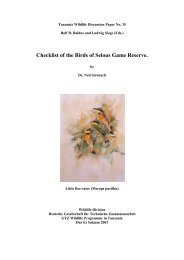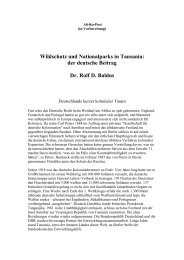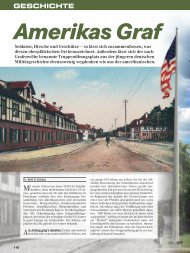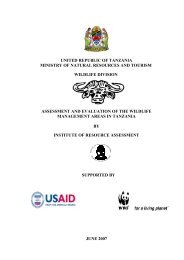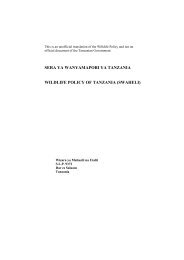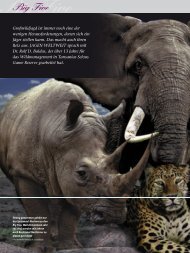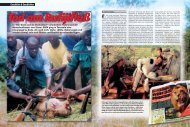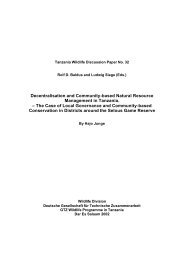Governance improvement and at the same time persisting hopes and illusions on the side of the donorsreward those in Africa who benefit from bad Governance and punishes those who want to reform. BadGovernance – or should I better say corruption - pays after all!Selous as Part of the Protected Areas’ SystemSome Facts on the Selous Game Reserve110 years ago, in the year 1896, the German Governor von Wissmann created a game reserve between theMgeta and Rufiji Rivers in the South of what was German East Africa at that time. The area became thenucleus of what is now the SGR. This makes it Africa's oldest protected area. The present size is approx.48,000 km².It is basically a "Miombo" dry-forest ecosystem, but it contains many other landscapes like savannahs,riverine forests and wetlands. Wildlife populations are of major international significance, e.g. elephant, lion,leopard, wild dog, crocodile, hippo, Roosevelt sable, Nyassa wildebeest and many others.The ecosystem extends beyond the borders of the reserve. Presently <strong>com</strong>munities south of the reserve havestarted to create their own <strong>wildlife</strong> protected areas. Thus a kind of ecological corridor will be created betweenthe Selous and the Niassa Game Reserve in Mozambique. An ecosystem of approx. 110,000 km² could thus<strong>com</strong>e eventually under coordinated conservation management.The main problems in the Selous remain poaching, an insecure financial basis and insufficient <strong>com</strong>munityinvolvement in the management of the buffer-zones.Start of SCP in 1987: Selous in CrisisIn the aftermath of "<strong>African</strong> Socialism" the <strong>wildlife</strong> sector in Tanzania deteriorated. The Selous elephantdeclined from approx. 110,000 in the early seventies to around 55,000 in 1986 and to less than 30,000 in1989. The rhino was poached during the same period from over 3,000 to less than a hundred. Themanagement system of the reserve had more or less broken down. There were two Landrovers operationaland the1987 l budget amounted to approx. 3 US$ per km². Governance was the core problem. More thanhalf of the poaching originated from the official staff, often on orders of superiors, higher authorities andpoliticians. With very few exceptions those responsible were never taken to court.104
Why SCP?The Tanzanian Government finally decided to take action to stop <strong>com</strong>plete destruction of a World HeritageSite. A request was made to Germany under development cooperation. The reasons for Germany to getinvolved were:• Biodiversity became a new development objective in a process which later led to the Rio-Conference.• Wildlife was recognized as a natural resource which allows sustainable use for poverty alleviation.• The role of <strong>com</strong>munities in nature conservation was increasingly stressed.Some Characteristics of SCPThe SCP from the very beginning followed a "hands-on" approach. It was based on conservationpartnerships between the Wildlife Division, the <strong>com</strong>munities in the buffer-zones and the districtadministrations. The initial donors were GTZ (management, infrastructure and <strong>com</strong>munities), FrankfurtZoological Society (aircraft), WWF (rhino and elephant expert) and <strong>African</strong> Wildlife Foundation (mechanic). Ata later stage KfW-German Development Bank, European Union, <strong>African</strong> Development Bank and USAID alsocontributed.Activity 1: Rehabilitation of the ReserveThe main activities were:• Anti-poaching• Training and equipment of scouts• Payment increases and new structures, incentives, discipline• Infrastructure: roads (from 1,700 km to 15,000 km), airstrips, <strong>com</strong>munication, transport, housing,2,000 km boundary demarcation• Management planning, organization, development of professionalismActivity 2: Creating Financial SustainabilityTwo options are open for the managers of protected areas:1. Attain financial self sufficiency in order to maintain minimum core functions (doing the necessarywith available public funding and own money) or2. Secure permanent external finance in order to afford <strong>com</strong>prehensive management (doing morethan what is necessary for survival and donor funds closing the finance gap)SCP opted for self sufficiency since it was assumed that tourism (hunting and photographic) couldgenerate sufficient revenue for management, allowing at the same time payments to central Government anddistricts. A retention scheme of 50 % was agreed with the Treasury by which the reserve was allowed toretain at least half of its in<strong>com</strong>e for management starting in 1994. In addition the Government paid basicsalaries. The management of the hunting industry (90 % of reserve in<strong>com</strong>e) incl. quota setting and blockallocation remained with the Ministry (Wildlife Division) and did not allow the Selous administration muchinfluence.Activity 3: Involving the CommunitiesThe Tanzanian Government had always followed the “fines and fences” approach, as this was the “state ofthe art”. Wildlife was to be protected by the state and local people had no right to utilize it unless they boughta hunting license. However, the Government had never the capacity to protect the resource and often it alsodid not have the political will to do so. Often the official law enforcement agencies were the main violators.At the beginning of the SCP in 1987 the only <strong>com</strong>munity involvement in <strong>wildlife</strong> management waspoaching. Community management of forests and <strong>wildlife</strong> has a long and successful tradition in many partsof the world including Germany, and SCP included from the very beginning “Community Based NaturalResources Management” into its concept. The objective was to share power and benefits with the<strong>com</strong>munities, let them have a word in the management of natural resources on their own land and use thematerial benefits as an incentive for the long term conservation of the resource. Sustainable use of <strong>wildlife</strong>was regarded as one of the few options left to maintain <strong>wildlife</strong> outside the protected areas. It is widely105



